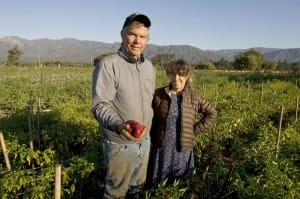Huffington Post
By Danielle Nierenberg
Co-authored by Delaney Workman
 Agriculture is responsible for approximately 70 percent of the world’s fresh water use, 20-30 percent of all greenhouse gas emissions, and 80 percent of global deforestation. But there doesn’t have to be a trade-off between a healthy planet and full plates.
Agriculture is responsible for approximately 70 percent of the world’s fresh water use, 20-30 percent of all greenhouse gas emissions, and 80 percent of global deforestation. But there doesn’t have to be a trade-off between a healthy planet and full plates.
Small-scale family farmers are feeding the world in ways that nurture local economies, social stability, and the Earth. These farmers have typically been using sustainable agriculture practices — rainwater harvesting, intercropping, agroforestry, and other methods — for generations.
Smallholder farmers operate more than 80 percent of the world’s agricultural holdings, and their farms usually measure less than two hectares. These farmers are nourishing their communities, protecting natural resources, increasing incomes and even breaking down gender barriers. To bring awareness to the crucial role that family farmers play in the global food system, the U.N. General Assembly has declared 2014 AS the International Year of Family Farming.
With the support of research institutions, the funding and donor communities, and eaters all over the world, family farmers have the power to nourish both people and the planet.
Each of these examples highlights that farmers aren’t just farmers — they are business women and men, innovators and teachers in their communities, entrepreneurs and stewards of natural resources.
1. Increasing incomes — In Indonesia, the Boyolali farmers’ association, Asosiasi Petani Padi Organik Boyolali [APPOLI], supported approximately 2,000 of its farmers in getting their organic grower certifications. Using organic practices reduced production costs by 40 percent, and additionally, the market price of organic rice is 20 percent higher than non-organic or conventional rice. As a result, the region’s organically certified rice farmers now enjoy an increased profit margin and greater incomes.
2. Mitigating climate change — Climate change and the natural disasters that come with it have had increasingly damaging effects on regions in sub-Saharan Africa, and have destroyed many farmers’ livelihoods. In Tanzania, small-scale farmers in six agro-ecological regions have already recognized patterns in temperature changes that predict drought, and are responding with improved irrigation and planting short-season crops, drought-resistant crops and trees to mitigate the effects that extreme weather can have on their plots.
3. Improving nutrition — In Malawi, agro-ecological small-scale farming practices have improved child nutrition. A Soils, Food and Healthy Communities (SFHC) project studied, specifically, whether intercropping cash crops such as maize, soybeans, and peanuts with pigeon peas and other legumes — a practice that protects soil health — would help to alleviate malnutrition. The project also incorporated educational programs that provided families with information on nutrition, and the benefits of using legumes as a source of protein in children’s diets. Communities that were involved with the project for long periods of time showed a significant increase in children’s height and weight.
4. Building social stability — In Enayetpur, Bangladesh, a local NGO provided a group of low-income rural women with the technology to raise farmed fish in small ponds. Even in a heavily male-dominated Islamic society, these women were able to maintain control of the fish farms and the income that they produced, using it to build their savings and social status.
5. Protecting valuable water resources — In Benin, a women’s agricultural cooperative implemented a solar drip irrigation system with the help of the Solar Electric Light Fund (SELF). Not only did this technology allow them to use less water more efficiently, but with it, the cooperative’s farm plots produced an average of 1.9 tons of produce per month.
6. Saving seeds and preserving indigenous crops — High in the Andes, small-scale farmers in Peru have undertaken a seed-saving project to protect over 1,000 native varieties of potato. In Parque de la Papa (Potato Park), indigenous farming communities grow their potatoes on mountain slope plots. They are collaborating with the Centro Internacional de la Papa (International Potato Center), a research institution in Lima, to preserve the seeds.
7. Organizing for greater market power — Women small-scale farmers and producers in a small town on the island of Lesvos, Greece established the Women’s Agricultural Cooperative of Pétra to increase their power in the market — and as a result, their incomes. After the demonstrated success of the cooperative, the Greek government established its national Women’s Agricultural Cooperative Council only two years later. The Pétra cooperative now acts as a major agro-tourism site, where women sell traditional Greek foods, such as olive oils and pastas.
8. Restoring soil health — Due to poor farming practices, a large part of the Mexican region of La Mixteca, north of the city of Oaxaca, turned to desert. A group of Guatemalan refugee farmers who came to the region taught local farmers how to restore soil health and reforest the land using traditional, agro-ecological farming methods. These farmers organized and formed CEDICAM (Center for Integral Farmer Development), and have since planted more than four million trees on the formerly barren land.
These stories highlight how farmers are finding ways to both nourish people and the planet. With more research and better investment in family farming, there will be even more stories to be told.
Danielle Nierenberg is the co-founder and president of Food Tank: The Food Think Tank.
Follow Danielle Nierenberg on Twitter: www.twitter.com/DaniNierenberg

